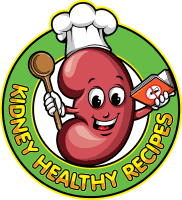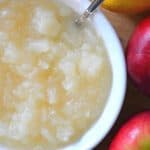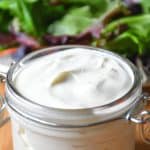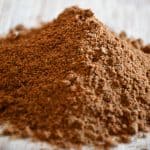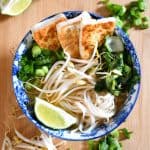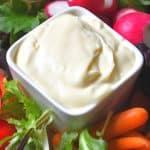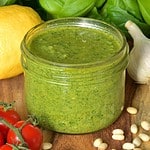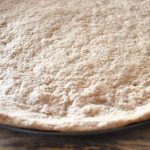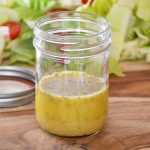A low sodium diet is a diet that significantly limits salt intake in order to maintain good health or treat certain health problems.
Some health professionals may recommend this type of diet using other terms such as “salt-free diet” or “low-sodium diet.” They are synonyms.
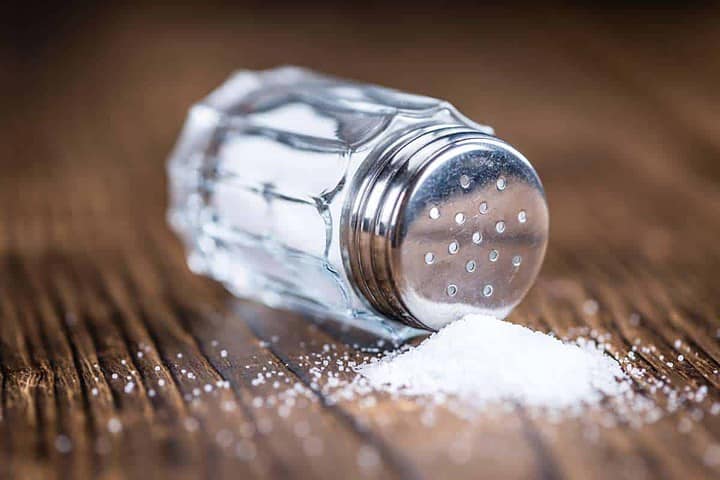
Estimated reading time : 20 minutes
What is sodium?
Sodium is both a mineral and an electrolyte. As a mineral, it occurs naturally in the environment as salt and is essential for many physiological functions, such as regulating fluid balance and blood pressure.
As an electrolyte, sodium also plays an important role in regulating electrolyte balance as well as transmitting nerve impulses and muscle contraction.
The difference between sodium and salt
Sodium and salt are often confused, but they are not exactly the same thing. The salt used in cooking is actually sodium chloride (NaCl) which is made up of both sodium and chloride. Specifically, salt contains about 40% of its weight in sodium, which means that for every gram of salt (1000 mg) we consume, about 400 mg of sodium is ingested.
The different types of salts and their sodium content
There are many types of salt on the market, each with different characteristics when it comes to taste, texture, and composition. Here are some examples of commonly used salts.
Table salt
Table salt is the most commonly used salt. Its crystals are white and very fine. It is often iodized to prevent iodine deficiency. One teaspoon (5 ml) of table salt contains 2300 mg of sodium.
Thus, regardless of whether it is natural, organic, fine or coarse, iodized or not, salt remains a very high sodium ingredient that must be used sparingly.
Kosher salt
Kosher salt is a salt used for the preparation of kosher foods. It has a coarser texture than table salt and is often used for its ability to absorb moisture. Its sodium content is similar to that of table salt.
Sea salt
Sea salt is a type of salt that comes from seawater. It is usually produced by evaporating seawater to obtain salt crystals. It can be fine or coarse and can vary in color depending on where it comes from and how it is produced.
It may contain minerals and trace elements in addition to sodium, hence the different flavor than table salt. Sea salts contain about the same amount of sodium as table salt, but less is generally used.
Himalayan pink salt
As its name suggests, Himalayan pink salt is a rock salt that is extracted from the Himalayan mountains. It has a distinctive pink color due to the presence of minerals and trace elements such as iron and calcium. For the same weight, it also contains the same sodium content as the other salts.
How much sodium to consume daily?
According to Health Canada, adequate sodium intake for an adult ranges from 1200 to 1500 mg of sodium per day1. It is therefore normal to consume a little every day. However, from adolescence, the daily sodium intake should be less than 2300 mg in order to prevent the occurrence of health problems such as hypertension and cardiovascular disease.
Unfortunately, according to the 2017-2019 Canadian Health Measures Survey (CHMS), Canadians’ sodium intake exceeds the tolerable upper intake level for the majority of age groups with an average of 2760 mg per day2:
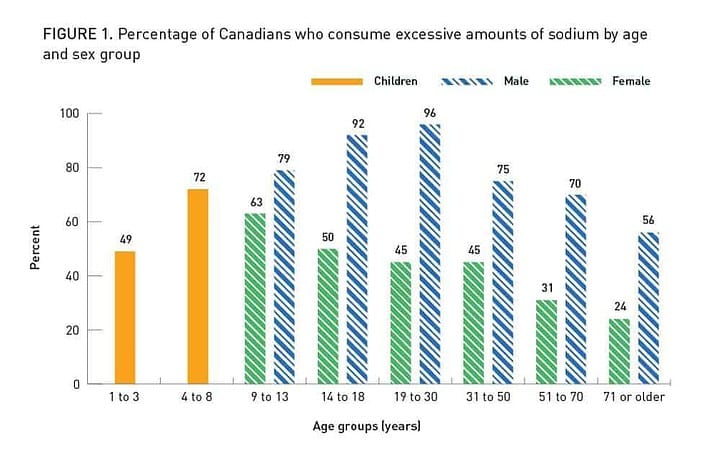
Contrary to what one might think, the low sodium diet, which is recommended in the treatment of certain diseases, is not more severe than the basic recommendation for the healthy population.
Thus, a low salt diet is a diet that contains between 1200 mg and 2300 mg of sodium, which is exactly the range recommended by Health Canada. So it’s safe to say that everyone should adopt a low sodium diet.
In addition, in the case of kidney disease, recent guidelines recommend limiting sodium intake to less than 2300 mg per day for all types of patients (kidney failure, dialysis or post-transplantation)3. Thus, sodium restriction is the cornerstone in the treatment of all kidney disease.
However, the limit of 2300 mg of sodium is not a target to be reached. It is best to aim for the minimum, while meeting your daily needs. Moreover, it is not recommended to consume less than 1200 mg of sodium per day because it still plays a crucial role in maintaining the body’s water and electrolyte balance, in addition to being essential for functioning of nerves and muscles.
Be aware that the sodium recommendations of the FDA (U.S. Food & Drug Administration) are similar and the latter also recommends a daily limit of 2300 mg of sodium4.
Finally, also know that the needs can also vary from one person to another depending on other health histories. If in doubt, consult your healthcare professional for your daily sodium limit.
Impacts of low sodium diet on health
Why does the body need sodium?
Although it should be limited, sodium is still an essential element in the human body because it plays several important roles in the maintenance of health and normal functioning of the body.
For example, sodium, as an electrolyte, helps maintain water balance in the body by regulating the amount of water in cells. It is also essential for the transmission of nerve impulses and for muscle contraction, including that of the heart muscle.
Sodium is also involved in the absorption of certain nutrients in the digestive system, such as glucose and certain amino acids. It also helps regulate blood pressure by working in tandem with potassium.
How do the kidneys process sodium?
Sodium is mainly absorbed in the small intestine. It is then transported into the blood, where it circulates until it is eliminated by the kidneys. The kidneys play a crucial role in regulating sodium in the body. They filter the blood to remove waste and excess sodium, then reabsorb an appropriate amount of sodium to maintain electrolyte balance.
So, when there is excess sodium in the body, the kidneys increase their excretion of sodium to maintain it. Conversely, in case of sodium deficiency, the kidneys decrease the excretion of sodium and increase its reabsorption.
Also, in case of dehydration, the concentration of sodium increases in the blood and the kidneys produce antidiuretic hormone (ADH) which helps to reduce the amount of water lost in the urine by increasing the reabsorption of water by the kidneys.
The kidneys therefore help to regulate sodium according to the needs of the body.
Who should eat a low sodium diet?
In the long term, too much sodium intake can seriously damage your health. The most well-known impact of excess sodium is the risk of hypertension. Thus, anyone with hypertension should adopt a low sodium diet.
Individuals with kidney disease, heart disease or a history of stroke should also reduce their salt intake as a secondary prevention. In addition, salt reduction is paramount in reducing kidney and cardiovascular complications in individuals with diabetes.
Why adopt a low sodium diet?
Of course, salt must also be significantly limited in the context of kidney disease. In fact, sodium reduction is the cornerstone of nutritional treatment for virtually all types of kidney problems.
Kidney failure5
People with kidney disease are very sensitive to the effect of sodium on raising blood pressure. Moreover, excessive salt consumption reduces the effectiveness of certain antihypertensive drugs.
In addition, when kidney function is reduced, the body has more difficulty eliminating excess sodium and fluids consumed. Excessive sodium consumption therefore leads to water retention called edema.
Since sodium stimulates thirst, reducing it may also help to better manage fluid intake for individuals who need to restrict it.
Proteinuria
Aside from its detrimental effect on blood pressure, high sodium intake also promotes the passage of protein in the urine (proteinuria). High proteinuria is a major risk factor for deterioration of kidney function.
Kidney stones6
Several types of kidney stones have as a common risk factor a diet that is too high in salt. This is because high sodium in the urine is associated with increased urinary calcium, which increases the risk of calcium-based stones such as oxalate and phosphate stones.
Polycystic kidney disease
Polycystic kidney disease is often associated with a high risk of developing kidney failure. Adapting the diet at the onset of the disease slows down the process.
Longitudinal studies have shown sodium to be one of the factors associated with faster disease decline. In fact, sodium restriction is part of the most recent Canadian consensus on disease management7.
The risks of consuming too little sodium
Although relatively rare in Western countries, insufficient sodium intake also carries certain health risks.
Dehydration
Sodium helps maintain the water balance in our body. Therefore, too little sodium intake impairs fluid retention in the body and can contribute to dehydration. The risk is present especially in people who sweat a lot, such as athletes.
Hypotension
As mentioned, sodium is essential for maintaining blood pressure in the body. In some people, not consuming enough sodium can cause blood pressure to drop too much, which can cause dizziness, lightheadedness, and sometimes even fainting.
Increased risk of bone fractures
A very low sodium consumption, below physiological needs, may be associated with a decrease in bone density, and therefore an increased risk of fractures. This is because sodium and calcium are closely linked in the body, and too much or too little sodium intake can affect calcium homeostasis in the body8.
Risk of kidney problems9
Too little sodium intake can also have negative effects on kidney health. Insufficient sodium intake can cause a decrease in pressure in the blood vessels of the kidneys, which can affect their elimination capacity. Lack of salt can also cause a drop in blood volume and blood flow to the kidneys, which can impair kidney function. Eventually, the amount of urine produced may be reduced and become more concentrated, increasing the risk of kidney stones.
So, while reducing sodium is paramount for the prevention and treatment of kidney disease, there is no benefit to reducing intakes below the recommended nutrient intakes. However, lack of sodium is rare in the North American diet because sodium is hidden in many foods, often without our knowledge.
Adjustment period
The time it takes to adapt to a salt restriction in flavor can vary from person to person. In general, it can take anywhere from a few weeks to several months for the taste buds to adjust to a significant reduction in salt intake10.
At first, foods may seem bland or tasteless, but over time, taste buds may adjust to a less salty flavor. People can also experience new flavors and learn to appreciate the natural tastes of food more.
Most of the time, no turning back is desired because foods that are too salty become unpleasant in the mouth.
Sources of sodium in the diet
Naturally occurring sodium
You should know that even if we do not add salt to our foods and we do not buy processed foods, we still consume sodium every day. Indeed, sodium is a chemical element that is found naturally in many foods.
Just like humans, animals have sodium as an electrolyte in their blood and muscles. Animal proteins therefore contain a little sodium. It is the same for milk which is a biological fluid of the cow.
In addition, plants absorb mineral salts from the earth, which explains the small amount of sodium found in fruits and vegetables.
However, naturally occurring sodium in foods contributes only 10% of the sodium consumed daily.
Added sodium
Added sodium is that which is added voluntarily via the salt shaker or that added by the food industry. The best-known source of sodium is of course the salt used at the table or for cooking food. However, be aware that this only represents 10% of daily sodium intake.
Therefore, eliminating the salt shaker is not enough to sufficiently reduce sodium intake. Thus, the majority of sodium consumed, or 80% of daily intake, comes from industrially processed foods and restaurant meals. This is called hidden salt.
How to know the sodium content of food
Nutrition labels
To significantly reduce your sodium intake, you must learn to read the Nutrition Facts table on food packaging. Sodium is one of the nutrients that must be listed in the table.
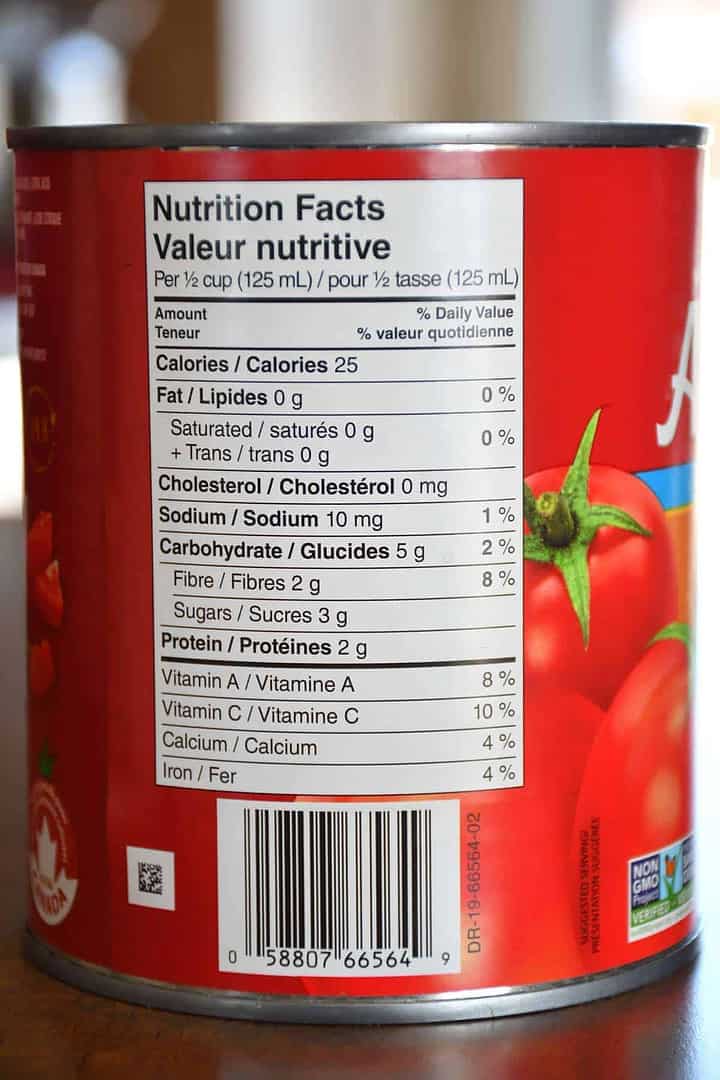
The sodium content for the same kind of food can vary greatly from brand to brand, and even from flavor to flavor for a given brand. Therefore, reading labels makes it easy to compare products with each other.
Generally, a food or ingredient is considered low in sodium when it contains less than 140 mg per serving, which is less than 6% of the Daily Value.
Also pay attention to the serving sizes on the label. For example, if you have to buy a loaf, choose one that contains a maximum of 140 mg per slice, which corresponds to less than 280 mg if the value is listed for 2 slices.
Also, make sure the serving size listed matches the serving size consumed. In the case of cheese, a serving is usually 30 g. If you choose a low sodium cheese but eat 2-3 times the suggested serving, your sodium intake will also be higher.
In the case of a complete meal, a sodium content of less than 600 mg is considered acceptable.
Nutritional claims
Also pay attention to nutritional claims on packaging. Foods labeled “reduced in sodium”, “less salt”, “no salt added” or “lightly salted” are not necessarily low in sodium. It only means that the product contains less salt than the original version.
For example, a “reduced-salt” soy sauce may still contain more than 600 mg of sodium per tablespoon. Instead, look for “sodium-free”, “salt-free”, “low sodium”, “low sodium”, “low salt” and “low sodium” claims, which correspond to foods that are actually low in sodium.
Here is a list of the most common nutrition claims allowed in Canada and what they mean.
Free of sodium or salt
The food must meet one of these criteria
- The food contains less than 5 mg of sodium per reference amount and serving of stated size.
- The food contains less than 5 mg of sodium or salt per serving of stated size, if the food is a prepackaged meal.
Allowed claims for this food
- free of sodium
- sodium-free
- no sodium
- 0 sodium
- zero sodium
- without sodium
- contains no sodium
- free of salt
- salt-free
- no salt
- 0 salt
- zero salt
- without salt
- contains no salt
No added sodium or salt
The food must meet this criterion
- The food contains no added salt, other sodium salts or ingredients that contain sodium that functionally substitute for added salt.
Allowed claims for this food
- no added sodium
- without added sodium
- no sodium added
- no added salt
- without added salt
- no salt added
- unsalted
Low in sodium or salt
The food must meet one of these criteria
- The food contains 140 mg or less of sodium per reference amount and serving of stated size and, if the reference amount is 30 g or 30 ml or less, per 50 g.
- The food contains 140 mg or less of sodium per 100 g, if the food is a prepackaged meal.
Allowed claims for this food
- low in sodium
- low sodium
- low source of sodium
- little sodium
- contains only (number) mg of sodium per serving
- contains less than (number) mg of sodium per serving
- low salt
- low in salt
- low source of salt
- little salt
- contains only (number) mg of salt per serving
- contains less than (number) mg of salt per serving
Reduced in sodium or salt
The food must meet one of these criteria
- The food is processed, formulated, reformulated or otherwise modified so that it contains at least 25% less sodium per reference amount of the food, than the reference amount of a similar reference food.
- The food is processed, formulated, reformulated or otherwise modified so that it contains at least 25% less sodium par 100 g, per 100 g of a similar reference food, if the food is a prepackaged meal.
Allowed claims for this food
- reduced in sodium
- reduced sodium
- sodium-reduced
- less sodium
- lower in sodium
- reduced in salt
- reduced salt
- salt-reduced
- less salt
- lower salt
- lower in salt
Lower in sodium or salt
The food must meet one of these criteria
- The food contains at least 25% less sodium per reference amount of the food, than the reference amount of a reference food of the same food group.
- The food contains at least 25% less sodium per 100 g, than 100 g of a reference food of the same food group, if the food is a prepackaged meal.
Allowed claims for this food
- lower in sodium
- less sodium
- lower sodium
- lower in salt
- less salt
- lower salt
Lightly salted
The food must meet this criterion
- The food contains at least 50% less sodium added than the sodium added to the similar reference food.
Allowed claims for this food
- lightly salted
- salted lightly
This information on official nutrient claims in Canada is taken from the article on nutrient content claims on the website of the Government of Canada11.
The official Food & Drug Administration (FDA) nutrition claims in the United States are similar. Here are the most common nutrient claims allowed on packaged food and drinks.
FDA nutrient claims
- Salt/Sodium-Free
Less than 5 mg of sodium per serving
- Very Low Sodium
35 mg of sodium or less per serving
- Low Sodium
140 mg of sodium or less per serving
- Reduced Sodium
At least 25% less sodium than the regular product
- Light in Sodium or Lightly Salted
At least 50% less sodium than the regular product
- No-Salt-Added or Unsalted
No salt is added during processing – but these products may not be salt/sodium-free unless stated
This information on official nutrient claims in United-States is taken from the article “Sodium in your diet” on the website of the FDA12.
How to reduce sodium intake
Now here are my favorite tips for reducing sodium intake.
The salt shaker
Even if the salt shaker represents only a fraction of the daily intake of sodium, its abandonment remains essential if one wants to desensitize oneself to the taste of salt and relearn to appreciate the true flavors of food.
Remember that there is a period of adaptation and resist the urge to use the salt shaker. Instead, enhance the flavor of your dishes with garlic, onion, ginger, citrus zest and different varieties of peppers, herbs and spices.
Salt free spice blends
There are also salt free spice blends that are composed of several different aromatics. Most contain a mixture of herbs, garlic, onion and pepper. Some are lemony and others spicy or sweet. There is something for all tastes and all types of dishes.
It is also possible to make your own blends using your favorite herbs. See the herb and spice blends recipe page for inspiration.
If you buy spice blends at the grocery store, make sure they are labeled “salt-free” and always validate your choice using the Nutrition Facts table. Good choices include DASH, McCormick, and salt-free versions from La Grille. Dion Spices also offers salt-free options.
Salt substitutes
You might be tempted to use “no salt” salt. However, avoid salt substitutes that look like salt like NoSalt, HalfSalt and Herbamare without sodium. They contain potassium chloride which is contraindicated in case of kidney disease.
In addition, be aware that aromatic salts such as garlic salt, onion salt and celery salt are made up mostly of salt. They are therefore not good alternatives. Use garlic powder, onion powder, and celery pepper instead.
Selection of products at the grocery store
The most effective way to reduce sodium intake is to make good choices at the grocery store using the Nutrition Facts table. That said, before rushing to the grocery store, I suggest you first familiarize yourself with reading nutrition labels with the foods you already have at home. Clean out your pantry, fridge and freezer. You will then be able to see where the salt is hiding in your diet and you will be able to prioritize the changes to be made afterwards.
Reading labels at the grocery store allows you to compare products with each other because there can be significant differences from one brand to another for the same category of products. However, be aware that the sodium content can also vary from flavor to flavor within the same brand. So, you have to get into the habit of always doing your checks, especially since companies sometimes change their recipes and the sodium content can vary.
However, trying to compile all of your daily sodium intakes is not necessary or recommended. In general, if all the products you buy at the grocery store are low in sodium, the meals you prepare at home will also be low in sodium.
Cook your own meals
As mentioned previously, ready-to-eat foods contribute to significantly increasing salt intake. These meals are often very high in sodium and their nutritional value is not always available. It is therefore best to limit their use and cook meals yourself with low sodium ingredients.
It is possible to adapt your favorite recipes by substituting certain ingredients that are too salty. If you tend to run out of time to cook, you can get into the habit of doubling or tripling recipes so you can freeze portions for other days.
If you are looking for new recipes, first direct your research to sites or books dedicated to kidney disease. You can take as an example this site, Kidney Healthy Recipes or the Spice it up! site.
There’s also the book Santé rénale – 21 jours de menus (Only available in French) which is a great source of kidney health information and great easy-to-make recipes.
How to reduce sodium intake when dining out
As you can see, it’s easy to drastically reduce your sodium intake by making good choices at the grocery store and adapting your recipes at home. The challenge is greater when eating out, as the sodium content of foods is rarely available.
In general, try to avoid fast food and reduce the frequency of meals eaten in restaurants or cafeterias. For example, you might plan to bring your lunch to work more often. Also, book restaurant meals for special occasions with family or friends, and make reasonable choices.
Dining out tips
- Avoid daily menus and tables d’hôte, as adding an appetizer and dessert to your main course can easily double the sodium intake of your meal. Restaurant soups are particularly high in salt.
- Avoid dishes in sauce or au gratin, breaded meats and fish as well as deli meats such as ham, sausage and pepperoni.
- Ask for dressings and sauces on the side so you can control the quantity.
- Choose natural side dishes, such as grilled vegetables, a baked potato or steamed rice.
- Don’t be afraid to leave some on your plate! Portions served in restaurants are often too generous.
- Remember to notify your server that you have a salt restriction. Restaurant owners are generally attentive to their customers. Moreover, if you eat regularly with friends or family members, do not hesitate to make them aware of your low sodium diet. After all, salt reduction is part of the health recommendations for all Canadians!
The low sodium diet in a nutshell
It is interesting to know that several beneficial health effects of salt reduction are visible in just a few days. This is the case, among other things, for the drop in proteinuria and blood pressure.
Moreover, there are certain points to watch out for when starting a sodium controlled diet. For example, if you are already taking medication for high blood pressure, doses may need to be lowered as a result of salt reduction. Measure your blood pressure at home and tell your doctor and pharmacist if your blood pressure is too low or if you feel dizzy.
Also, it is normal to notice a slight weight loss when you cut salt from your diet. This is due to a decrease in water retention caused by sodium. If you are taking diuretic medications, it is important to weigh yourself regularly. If your weight drops too much, contact your doctor who can adjust your diuretic downwards if necessary.
In short, reducing the sodium in your diet is a concrete action you can take to better control your kidney disease and to prevent its progression and associated complications. It can also help you reduce the number of medications you take each day.
In addition, since salt reduction is a society issue, all members of your household will benefit from the associated protective effects.
References
1. https://www.canada.ca/en/health-canada/services/food-nutrition/healthy-eating/dietary-reference-intakes/tables/reference-values-elements-dietary-reference-intakes-tables-2005.html
2. https://www.canada.ca/en/health-canada/services/publications/food-nutrition/sodium-intake-canadians-2017.html
3. Ikizler TA, Burrowes JD, Byham-Gray LD, et al; KDOQI Nutrition in CKD Guideline Work Group. KDOQI clinical practice guideline for nutrition in CKD: 2020 update. Am J Kidney Dis. 2020;76(3)(suppl 1):S1-S107.
4. https://www.fda.gov/food/nutrition-education-resources-materials/sodium-your-diet
5. Ikizler TA, Burrowes JD, Byham-Gray LD, et al; KDOQI Nutrition in CKD Guideline Work Group. KDOQI clinical practice guideline for nutrition in CKD: 2020 update. Am J Kidney Dis. 2020;76(3)(suppl 1):S1-S107
6. Ferraro PM, Bargagli M. Dietetic and lifestyle recommendations for stone formers. Arch Esp Urol. 2021 Jan;74(1):112-122. English, Spanish. Erratum in: Arch Esp Urol. 2021 Oct;74(8):725-726.
7. Soroka S, Alam A, Bevilacqua M, Girard LP, Komenda P, Loertscher R, McFarlane P, Pandeya S, Tam P, Bichet DG. Updated Canadian Expert Consensus on Assessing Risk of Disease Progression and Pharmacological Management of Autosomal Dominant Polycystic Kidney Disease. Can J Kidney Health Dis. 2018 Oct 12;5
8. Hannon MJ, Verbalis JG. Sodium homeostasis and bone. Curr Opin Nephrol Hypertens. 2014 Jul;23(4):370-6.
9. Institute of Medicine (US) Committee on the Consequences of Sodium Reduction in Populations. “Sodium Intake in Populations: Assessment of Evidence.” National Academies Press (US), 2013.
10. Ponzo V, Pellegrini M, Costelli P, Vázquez-Araújo L, Gayoso L, D’Eusebio C, Ghigo E, Bo S. Strategies for Reducing Salt and Sugar Intakes in Individuals at Increased Cardiometabolic Risk. Nutrients. 2021 Jan 19;13(1):279.
11. https://inspection.canada.ca/food-labels/labelling/industry/nutrient-content/eng/1389905941652/1389905991605
12. https://www.fda.gov/food/nutrition-education-resources-materials/sodium-your-diet
